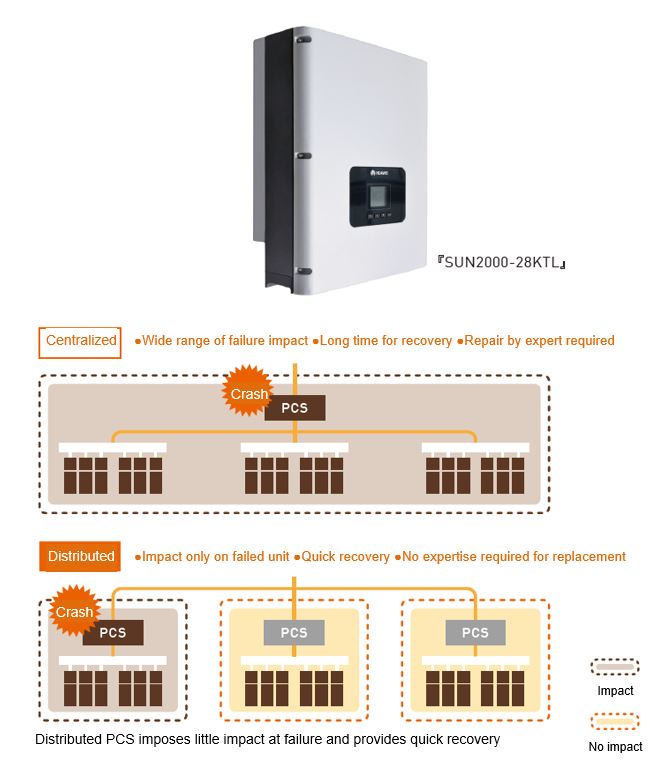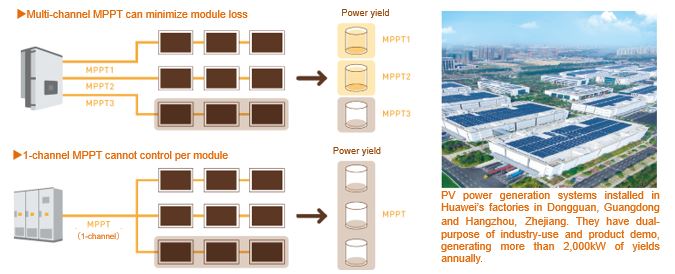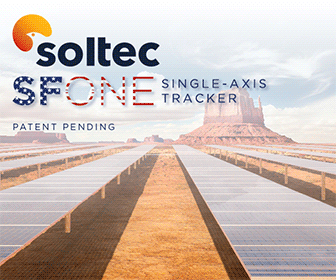Huawei's Distributed PCS To Enable Highly Efficient PV System with Easy Deployment and Management
 *SPECIAL INTERVIEW*
*SPECIAL INTERVIEW*
Interview with Mr. Shoichi Sakae
Director of Environment and Energy Business Unit, Tokyo Head Office, Daiwa House Industry Co., Ltd.
Since 2010, Huawei has been introducing Power Conditioning System (PCS) for large-scale PV Power Generation Systems into the global market. Converting direct current (DC) generated by solar panels into alternating current (AC), a PCS plays an important part in determining the efficiency of power generation of the entire system. When developing a product, Huawei applied the power supply technologies designed for telecommunication networks and added 10.5GW of capacity in 2015. Its market share is growing. In Japan, the company made its way into the market in 2014 and has greatly increased the number of shipments since last year. In this issue of HuaWave, we sat down with Mr. Shoichi Sakae, Director of Environment and Energy Business Unit, Tokyo Head Office, Daiwa House Industry Co., Ltd. who has adopted Huawei PCS “SUN2000-28KTL” in their mega solar business where they provide an EPC (Engineering / Procurement / Construction) service to the large-scale PV power generation systems to talk about their assessment on the product as well as the partnership with Huawei.
Environment and Energy Business Unit | Daiwa House Industry Co., Ltd.
Established in 2009 to branch out its business based on the house building know-how, the unit takes four environment and energy solution approaches; “Energy Saving,” “Energy Creating,” “Energy Reserving,” and “Building Renovation”. As “Energy Creating” approach, they undertake the construction and maintenance of PV power generation systems and mega solar for industrial use including factories, warehouses and stores. In 2015, the group’s total annual capacity with affiliate companies combined reached 700MW.

Speedy Construction and Maintenance
With Power Yields Going Up 5 - 10%
Huawei: Many players from various industries are embarking on EPC for solar PV systems. How do you differentiate yourself from competitors?
Mr. Sakae: One of the elements is “speed”. Whether it be construction or management, the longer it takes, the higher the capacity loss becomes. We can leverage our advantage as a builder to build facilities promptly, and cooperate with group companies to provide consistent service up through O&M (Operation and Management), which would put forward unique value to our customers. The installation of the distributed PCS is part of that plan.
Huawei: What do you see as the advantage of the distributed PCS?
Mr. Sakae: The traditional large-scale PCS was about the size of a vending machine with the weight close to one ton, which has made it hard to find an installation place and required an extensive installation work with heavy machines. On top of that, when there was a failure, a manufacturer had to send an engineer onsite to carry out time consuming process to figure out a cause and fix the problem. All the panels connected to the concerned PCS were to be affected until its recovery. It also meant that more devices would be affected as system scale increases.
On the other hand, Huawei’s Distributed PCS is 50 times smaller than the large-scale system with the weight of about 50kg. It can be carried around easily. No heavy machines or foundation work is required, and you can install it effortlessly. Fewer number of connected panels means smaller areas being affected. Since you just have to replace a failed unit with a spare, the recovery is fast. In fact, the recovery period has been reduced from one week of a large-scale system to two days. No other product has ever fulfilled the needs for a high speed construction and management at this level.
Huawei: Would you say customers also recognize such advantage?
Mr. Sakae: Yes, it is highly regarded. In addition to its high-speed feature and low risk at failure, the system boosts energy yields, which is very appealing to customers. The distributed architecture and multi-MPPT (figure on the next page) lift the power generation rate, while the compact design saves the installation space and makes room for extra panels. As a result, the power yields have found a 5 - 10% increase.
Facility Visit and Demo Gave Confidence in Huawei’s Technical Competence
Huawei: What brought you to consider Huawei’s PCS as your option?
Mr. Sakae: I did not know anything about Huawei back then. But later on I had a chance to see Huawei products for the first time at a domestic exhibition, and their high capabilities impressed me. In order to have better knowledge, I paid several visits to headquarters and factories in China, and saw demos at the HQ facilities. I was astonished by large factories and testing facilities. At the same time, I found out that Huawei has brought about innovation with its distributed base station likewise to the field of its core business, namely the telecom industry, and that it has been providing products capable of standing various types of environment worldwide. I was convinced that the technology of distributed PCS, its high resilience and availability, is also reinforced by such experience and track record of expertise. So we started out with a small-scale installation, and now more than 3,000 PCSs are deployed in the mega solar system across Japan.
Huawei: What was a decisive factor to choose Huawei that has just started PCS business in the Japanese market?
Mr. Sakae: To be honest, it was not well received internally at first. Since we operate in different industries, we did not know that Huawei is a big global company. We even considered taking out insurance upon concluding a contract. However, since I went and saw demos for myself and had our engineers go onsite to validate, I was confident about Huawei’s technological capabilities being able to gain understanding. I kept asserting that if we used this innovative product, we could do something that no other company had ever done, which would become our unique strength. Consequently, it has turned out to have a positive outcome, which endorsed this new challenge as worth trying.
Envisioning Ten Years Partnership To Grow Together
Huawei: You have been working with Huawei since we embarked on PCS business in Japan. Can you share us any issues you saw with respect to Huawei’s sales or support?
Mr. Sakae: In the early days, as they did not even have document in Japanese, we made some difficult requests. Huawei took our demands seriously and moved quickly. Right now, we communicate regularly and react swiftly to what the other party say.
Huawei: Please let us know any proposals or expectations for Huawei going forward.
Mr. Sakae: I think Huawei is the best partner who can make us achieve our goal to become unique and prompt. With its excellent technological capabilities, they can further grow in this field. We are yet to have a smart monitoring solution designed for the system that is good enough. I expect Huawei to take a close look at the needs of Japanese market to keep making improvements and create a product unique to Huawei. The mega solar business is a new area for us too, so we would like to grow together through our partnership in the next five years or even ten years going forward.

In the PV power generation systems, since the current and voltage constantly change depending on the weather, a function called MPPT (Maximum Power Point Tracking) is provided to decide the combination of current and voltage that would result in maximum power generation. Huawei’s distributed PCS has multiple MPPT units for efficient power generation. A failure on one module will not affect other modules, and it can be identified precisely and quickly.
Huawei Technologies Co., Ltd.










.jpg?r=4461)
.gif?r=6290)
.jpg?r=4871)